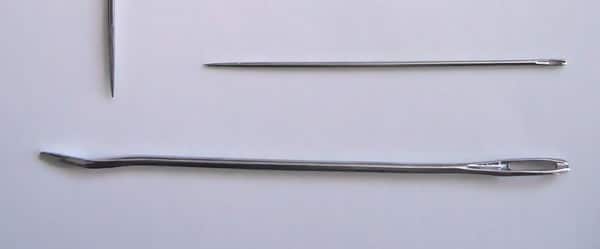Finding a Needle in a Needlestack Using Phage Display

Few things can dash your hopes quite like phages. They can annihilate whole bacteria cultures in the blink of an eye, and make your next cloning or expression project impossible. But you can harness these evil-do-ers for good. And use phages to screen massive libraries of peptides. Learn how below.
The Typical “Evil” Phage Experience
It is a cold and rainy morning as you excitedly stride into your darkened lab. Despite the weather your spirits are buoyant. You’re growing up a huge culture of bacteria expressing an enzyme that is sure to catalyze graduate student tears into gold. You can already see your name on that Nature paper! Smiling you flip on the light, grab the flask, and eagerly hold it up.
But, instead of seeing a bottle full of beautiful foggy amber, your media is as clear as when you inoculated it! And except for the look of wet bread-crumbs on the bottom of the flask it appears lifeless. Suddenly you find yourself fighting back tears as your stomach sinks to your knees. What monster?! What BEAST could do this to you?! But you already know the answer: Phages.
What are Phages?
Phages (short for bacteriophages) are viruses that infect bacteria. Like human viruses, phages hijack the molecular workings of their hosts and use their machinery to make more of themselves. This process ultimately kills the host cells and spews thousands of new phages into the media. A procee which repeats until your culture is completely annihilated. But what if I told you that this technology can be harnessed for good, instead of the aforementioned evil?
Phages for Good
Phages are also the central component of a technology known as phage display. In this method researchers fuse polypeptides to the coat or tail proteins of phages. Doing this enables researchers to screen massive libraries of peptides,- sometimes with as much as 1011 total unique peptides! You can then use this library for such things as identifying novel binding partners to your protein-of-interest, map binding epitopes between two proteins, or generate useful monoclonal antibodies for use in Western blots, ELISA, or other immunoassays. Not bad…not bad at all.
How Phage Display Works
After the purification of whatever protein you’re studying, this process begins by propagating your phage-peptide library. One common technique to achieve this begins with acquiring E. coli that each contain a phagemid – a plasmid that codes for an antibody region genetically fused to a phage protein. To produce active phages from these cells, these cells are grown in culture with helper phages that induces the production of phages that incorporate the fusion protein into the viral particle.
After the phages are propagated, they can be purified straight from the supernatant with the addition of a chemical called polyethylene glycol (PEG) and salt, which instantly turns your supernatant into a white cloud that can be centrifuged out of solution. Once resuspended, the phages can be counted using by titering the total population out and infecting actively growing E. coli. E. coli are spread throughout a soft agarose layer on a rich media plate, and plaques counted the next day.
Once quantified, your phage population will be exposed to your purified protein-of-interest (or cell, or peptide, etc.) immobilized on some surface, usually a plastic tube or a plate specially treated to non-specifically bind protein. This interaction is then washed multiple times with a buffer containing detergent. This washing helps to maximize specificity and select for phages that are binding with the greatest efficiency. This process is called panning.
After the panning is complete, the phages can be released from the target protein. This is usually done via an enzymatic reaction. These phages are then used to infect a new set of cells. It is important to remember that these phages are deficient in replication. Instead they will inject their genetic material, complete with an antibiotic marker, into a single bacterial cell without killing the bacteria. This will allow you to amplify these cells and the genetic material responsible for the synthesis of the binding protein, express the binding protein, or amplify new phage for further panning.
To What End?
Like most molecular techniques, what you do with the synthesized protein depends completely on your project. I have used phage display and panned three times to improve specificity against a bacterial protein I was studying. My next step was to screen for the phage binding to my target, sequence the antibody fragment that was expressed on these phage tails, and purify the fragment. Then I measured the affinity and improved its binding alanine scanning. Eventually I created a novel detection assay using this antibody fragment.
But once your binding partner has been purified there are a million directions you can take these experiments. The only question really is – once you’ve pulled out your needle from a stack of (109) needles, how can you use it to stitch